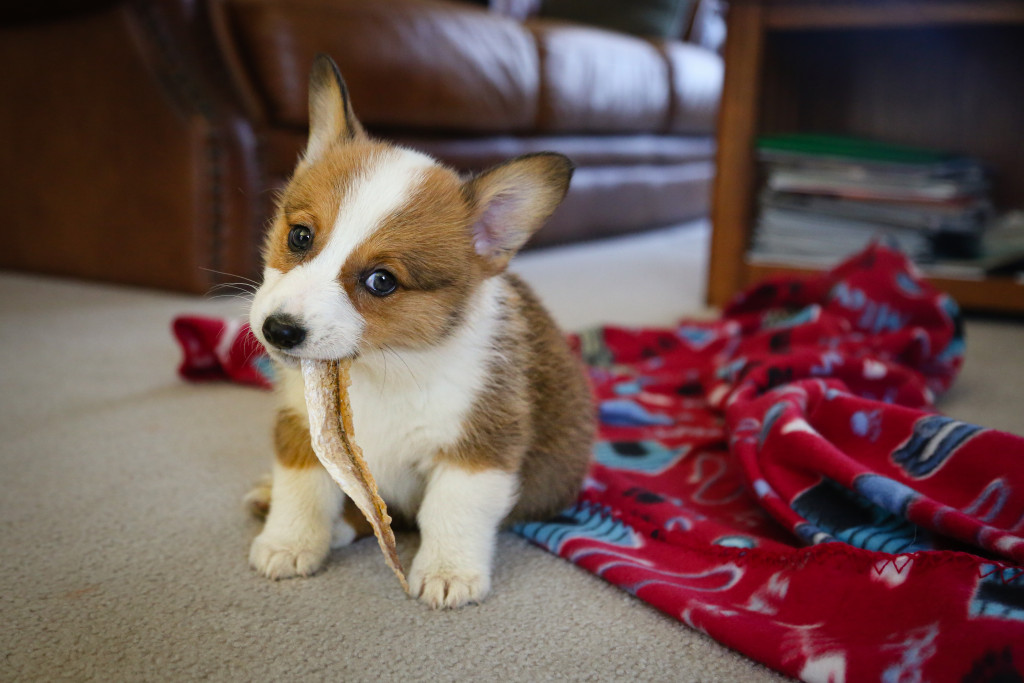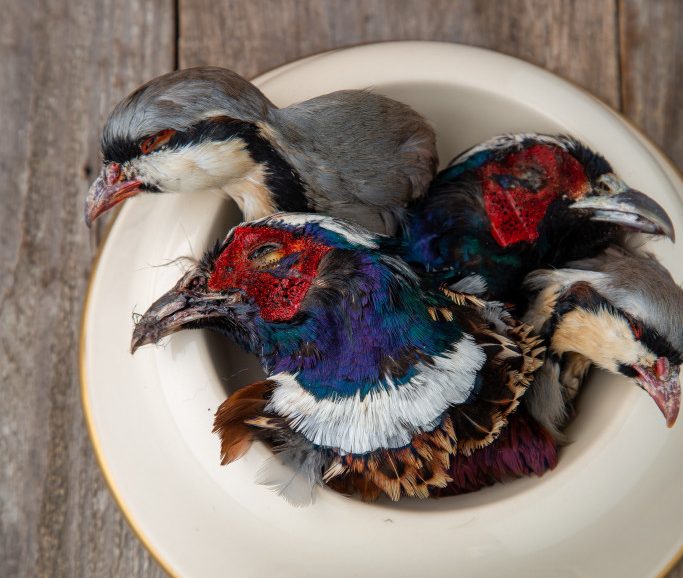Your Dog Will
Enlarge

Story and photo by Jenny Nguyen-Wheatley
Pheasant heads, freezer-burned fish, deer liver, duck feet … these are things that I might have tossed in the past. There are parts of an animal that I simply can’t use. Or waste from freezer-burned meat. Or meat that ended up not tasting good. I hate waste, but it happens. So, when my husband and I brought home our 8-week-old Pembroke Welsh corgi puppy last winter, our problems were solved. I’ve come up with a few creative, easy ideas to use as much of the game and fish that we accumulate throughout the year as possible.
But first, talk to your pet’s veterinarian before introducing any new foods. Once you get the OK, have fun exploring these wild treats.
Bird Heads
Pheasant, chukar, grouse, duck, etc., all work here. The bones in the heads of game birds are soft, and the meat and brains are enticing to dogs. With kitchen shears, cut off the beaks before offering to your dog (not pictured), which can be sharp and hard. Do not offer head-shot birds to avoid lead poisoning.
My dog digests limited amounts of feathers OK. According to many sources, including nakedbeasts.com — who provides “holistic healing pet treats and chews for dog and cat owners” — fur and feather in a canine’s diet can be beneficial: “The fur and feathers are fully digestible and provide an essential source of manganese as well as a natural means of colon cleansing. By allowing the natural fibers of the fur and hair to sweep off the excess debris of food and gunk along your pet’s intestinal walls, they are more readily available to absorb minerals and nutrients more efficiently.”

Feed fresh or for longer shelf life, dehydrate in a food dehydrator. To dehydrate, run kitchen sheers along the neck and top of the head to open up the head cavity, which will allow them to dry more thoroughly and prevent early spoilage. Dry times will vary, but I like to dry at 135 degrees for about 4 hours and then turn the temperature up to 165 degrees until fully dried. Allow heads to cool completely before storing them in a partially closed zip-top bag in the refrigerator. Watch for condensation in the bag, which would indicate that the heads were not fully dried.
Use within two weeks. Freeze for longer storage.
Fish Jerky
Jerky is a great treatment for freezer-burned fish fillets or fish that might not taste as good as you’d hope. My husband caught a whole mess of bullhead catfish one summer, which were unfortunately unpalatable for the table — no problem for Fergus though. Dry boneless fillets at 165 degrees for several hours; dry time will vary.
Store in the refrigerator for up to 1 month. Vacuum seal and/or freeze for long-term storage.
Deer Flank Jerky
That thin flap of belly meat that runs between a deer’s ribs and its hind end is called the flank. It’s often layered with silver skin and fat, which I don’t like to run through my meat grinder because the silver skin binds up my machine. Flank is too gristly to make jerky for human consumption, and the thick layers of fat are a pain to remove for slow cooking. Fortunately, all that won’t matter to your dog. The more silver skin, the longer the chew will last.

Cut the flank into desired-size pieces and dehydrate at 165 degrees until fully dried. Fat is desirable, but trim off excess layers; feeding a dog too much fat at one sitting can cause diarrhea.
Flank jerky will keep in the refrigerator for up to 1 month. Venison fat can go rancid quickly, so watch for that.
Deer Liver Chews
Out of all the wild game and fish I’ve given Fergus, deer liver chews seem to be his favorite. Organs are highly nutritious for dogs, so it makes me feel good that I no longer have to leave most of the liver with the gut pile. I keep it frozen until we’re ready to make these treats.
Cut the liver into fourths and soak it in water for 30 minutes to release excess blood. Then rinse and cut into bite-size pieces, accounting for 30 percent shrinkage. Pat completely dry with paper towels. Lay on dehydrator trays, allowing room in between each piece for air flow, and dehydrate at 135 degrees for 3 hours. Then turn up heat to 165 and dehydrate until fully dried but still chewy.

Duck/Goose Feet
The bones in duck or goose feet don’t splinter, and they are full of beneficial cartilage. Wash feet thoroughly and clip off the toenails before feeding fresh to your dog. For a longer-lasting treat, dehydrate waterfowl feet at 165 degrees until fully dried.

Fish Skin
If every angler had a dollar for all the fish they’ve filleted in their life … . If you can’t turn that work into money, then you might as well save money by turning the fish skins into dog treats. Dry fish skins at 165 degrees until fully dried; small scales are OK. Lay them flat on trays or twist them to make “sticks.” ■
Disclaimer: Feed at your own risk and supervise dogs when offering wild game treats. Gradually introduce new foods to avoid stomach upset and account for allergies. Store all treats in the refrigerator or freezer. If mold occurs, do not feed.
The post Not Going to Eat That? appeared first on Nebraskaland Magazine.
















